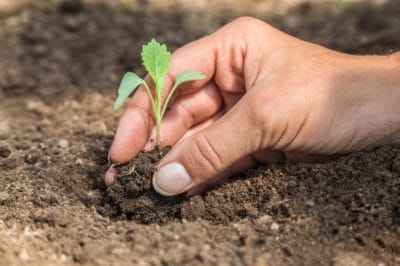Planting Cabbage in the Spring
When you plant your cabbage in the spring depends on whether you plan to buy seedlings to transplant, sow your seed directly into your garden, or start seeds to raise your own seedlings to transplant.
Starting Your Own Seedlings
If you want to start seeds to grow your own seedlings, you should sow them six to eight weeks before the last frost date in your area. Space them 2 inches apart and cover them with 1/4 inch of soil. Keep them in an sunny area or under a grow light or a cool white florescent light in a space where the temperature remains between 65-75°F (18-24°C).
One to two weeks before you plan to transplant your seedlings, after the temperatures outside reach a steady 50°F (10°C) and your seedlings have developed two or three pairs of leaves, you can begin acclimating them by moving them outdoors. Leave them outdoors for longer periods each day.
Sowing Your Seeds Directly Into the Soil
If you plan to sow your seeds directly into your garden, wait until two weeks before the last frost date in your area. Space the seeds 2 inches apart and cover them with 1/2 inch of soil in rows that are 12 to 24 inches apart.
Transplanting Seedlings
Whether you have purchased seedlings or grown your own, transplant your seedlings two to three weeks before the last frost date for your area.
Place them in holes deep enough to cover the roots and 2 to 3 inches of the stem in rows 12 to 24 inches apart. If you would like to have some small heads to harvest early, plant your seedlings 6 inches apart and then harvest every other one when the heads become firm. Otherwise, plant your seedlings 12 inches apart. For cabbages with larger heads, wait until your seedlings are 5 inches tall and thin them to 24 inches apart. Simply transplant the seedlings you thin to another area of your garden.
Replanting for a Continuous Harvest
If you want cabbage to harvest all season long, replant seeds or seedlings every two weeks after your first spring planting. You can also plantdifferent varieties of cabbage that have different times to maturity.
Planting Culinary Cabbage for the Fall
As with ornamental cabbage, if you want culinary cabbage to harvest in the fall, you should plant it three to four months before you want to be able to harvest it. Aim for a planting date in mid to late summer for culinary cabbage.
Planting Ornamental Cabbage
If ornamental cabbage is planted while the weather is too warm it becomes leggy rather than growing close to the ground, and it remains green instead of developing those lovely, rich colors. So, you can plant ornamental cabbage later than culinary cabbage. However, if you are starting your own plants from seedlings, you should sow your seeds no later than 10 weeks before the last frost date in your area. The one important difference between culinary cabbage and ornamental cabbage is that, when growing ornamental cabbage from seed, you do not cover the seeds with soil.
